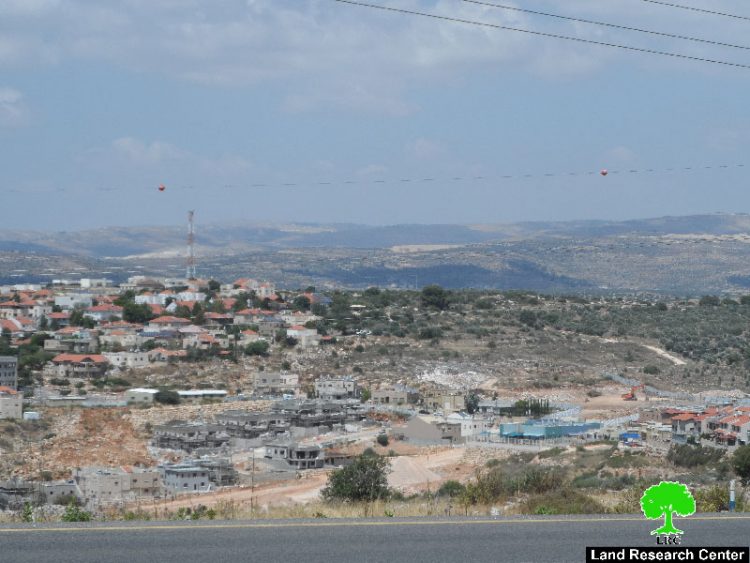- Violation: expanding a colony at the expense of Palestinian lands
- Location: Salfit governorate
- Date: June 01, 2016
- Perpetrators: so-called Settlement Council of the West Bank
Details:
The colonization plan seeks to take over and control the area of the West Bank to separate Palestinian cities and villages from each other. It should be marked that Revava colony is undergoing an expansion activity from its southern part. Field researchers from Land Research Center asserted that 13 residential units were under construction in there. It is reported that the western side of the colony witnessed the annexation of 25 residential caravans within a newly established quarter.
The new quarter is reported to be founded on lands confiscated in 2000 by military orders under the claim of “security purposes”. The occupation managed to take over the lands despite possessing private Palestinian ownership.
Since 2000, the confiscated lands are declared inaccessible for Palestinians even during olive harvesting season. This gave a room for colonists and the Council of Settlements to open roads and establish new infrastructure that serve the colonial expansion in the area.
It should also be marked that the colony itself underwent a massive expansion represented in the ravaging of 35 dunums to its eastern and northern sides for the sake of adding infrastructure and services facilities. This is to accommodate dozens new Israeli families in the area.
Photos 1-3: the recent expansion on Revava
During the past year of 2015, the occupation government called for tenders to establish residential units in the West Bank. Revava colony had a great share from those tenders.
About Revava colony:
The colony of Revava started in 1991 on confiscated lands from Deir Istiya village. It totals 1540 dunums in area, of which 160 are the colony’s built up area. Revava has a total population of 827 by 2005. (Middle East-Washington Peace)
The colony of Revava, since its establishment, formed an obstacle in the face of the Palestinian building movement in the area of Deir Istiya in addition to the confiscation of vast area of agricultural lands and the ban on sheep grazing in the periphery of Israeli colonies.
About Haris:
Seven km to the northwest of Salfit governorate, Haris is located with a total land area of 8769 dunum, of which 190 dunums are the village’s built-up area. Haris is surrounded by the villages of Deir Istiya from the north, Kifl Haris from the east, Kfar ad-Dik and Bruqin from the southwest and Qarawat Bani Hassan from the west.
It has a total population of 3740 people according to the census of Palestinian Central Bureau of Statistics for 2009. Those people hail from the following families: Abu Atta, Dawoud, Salamih, Sultan, Shihada, Souf, Faz', Awwad, Qasim, and Klaib. The Israeli occupation confiscated 3631 dunums from the village as follows :
- Israeli colonies confiscated 2672 dunums as detailed in the below table
|
colony |
Year of establishment |
Confiscated area\dunum |
Number of colonists |
|
Kiryat Netafim |
1982 |
188 |
384 |
|
Revava |
1991 |
269 |
703 |
|
Burkan |
1981 |
177 |
1207 |
|
Burkan Industrial |
1981 |
1346 |
— |
|
Ariel Industrial |
— |
692 |
— |
|
Total |
|
2672 |
2294 |
- 726 dunums were confiscated to open the bypass roads numbers ( 505, 4765, 5506)
- The apartheid wall confiscated 233 dunums for its establishment. Upon its completion, the wall will isolate 7135 dunums
According to Oslo Accords, the lands of Haris are classified as follows:
- 631 dunums are classified as area "B"
- 7815 dunums are classified as area "C"
UN Security Council resolutions in regard to Israeli colonies:
UN Security Council resolution 446, article 3 " Calls once more upon Israel, as the occupying Power, to abide scrupulously by the 1949 Fourth Geneva Convention, to rescind its previous measures and to desist from taking any action which would result in changing the legal status and geographical nature and materially affecting the demographic composition of the Arab territories occupied since 1967, including Jerusalem, and, in particular, not to transfer parts of its own civilian population into the occupied Arab territories;"
- Un Security Council resolution 452, article 3"Calls upon the Government and people of Israel to cease, on an urgent basis, the establishment, construction and planning of settlements in the Arab territories occupied since 1967, including Jerusalem;"
-
Un Security Council resolution 465, Strongly deplores the continuation and persistence of Israel in pursuing those policies and practices and calls upon the Government and people of Israel to rescind those measures, to dismantle the existing settlements and in particular to cease, on an urgent basis, the establishment, construction and planning of settlements in the Arab territories occupied since 1967, including Jerusalem;
Calls upon all States not to provide Israel with any assistance to be used specifically in connexion with settlements in the occupied territories;
-
Un Security Council resolution 242, Affirms that the fulfilment of Charter principles requires the establishment of a just and lasting peace in the Middle East which should include the application of both the following principles:
(i) Withdrawal of Israel armed forces from
territories occupied in the recent conflict;
(ii) Termination of all claims or states of belligerency and respect for and acknowledgment of the sovereignty, territorial integrity and political independence of every State in the area and their right to live in peace within secure and recognized boundaries free from threats or acts of force;
Prepared by
The Land Research Center
LRC

















